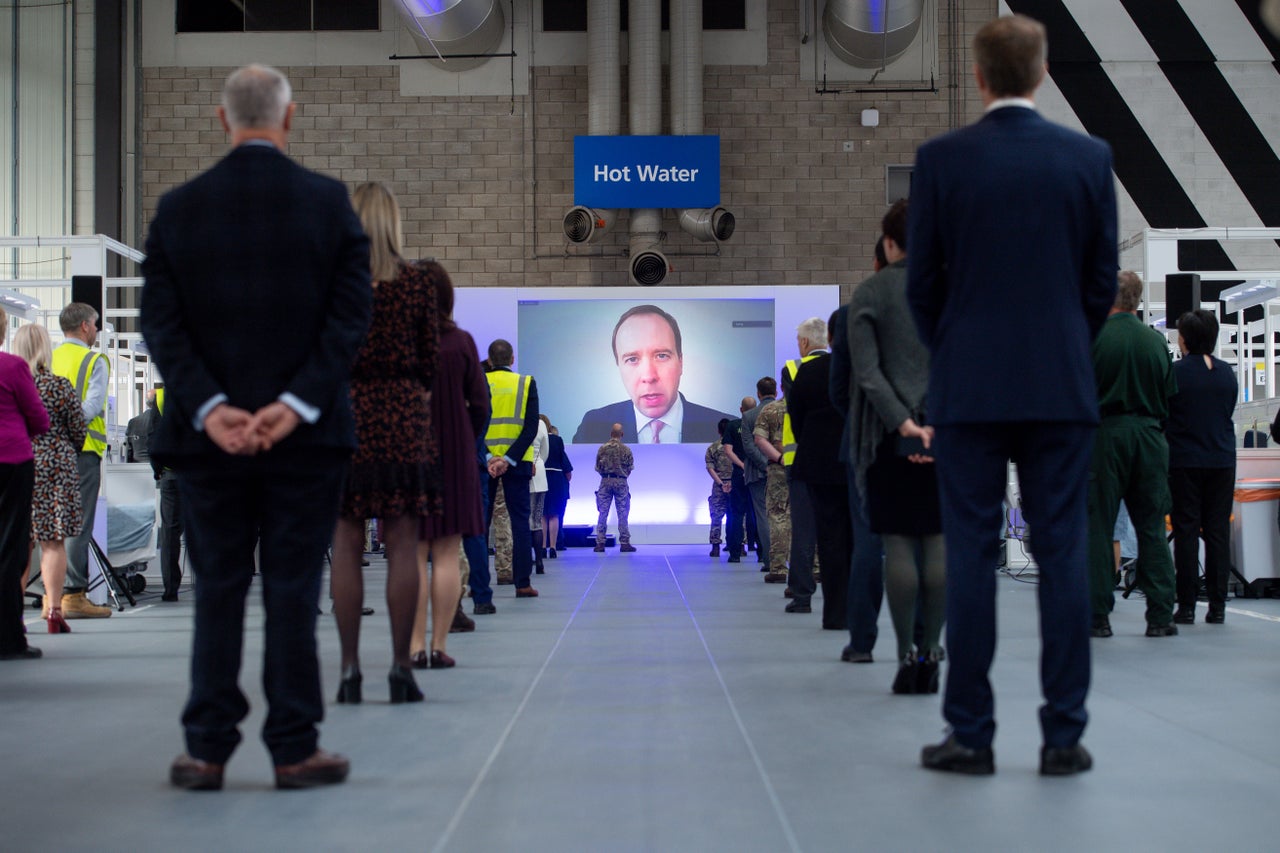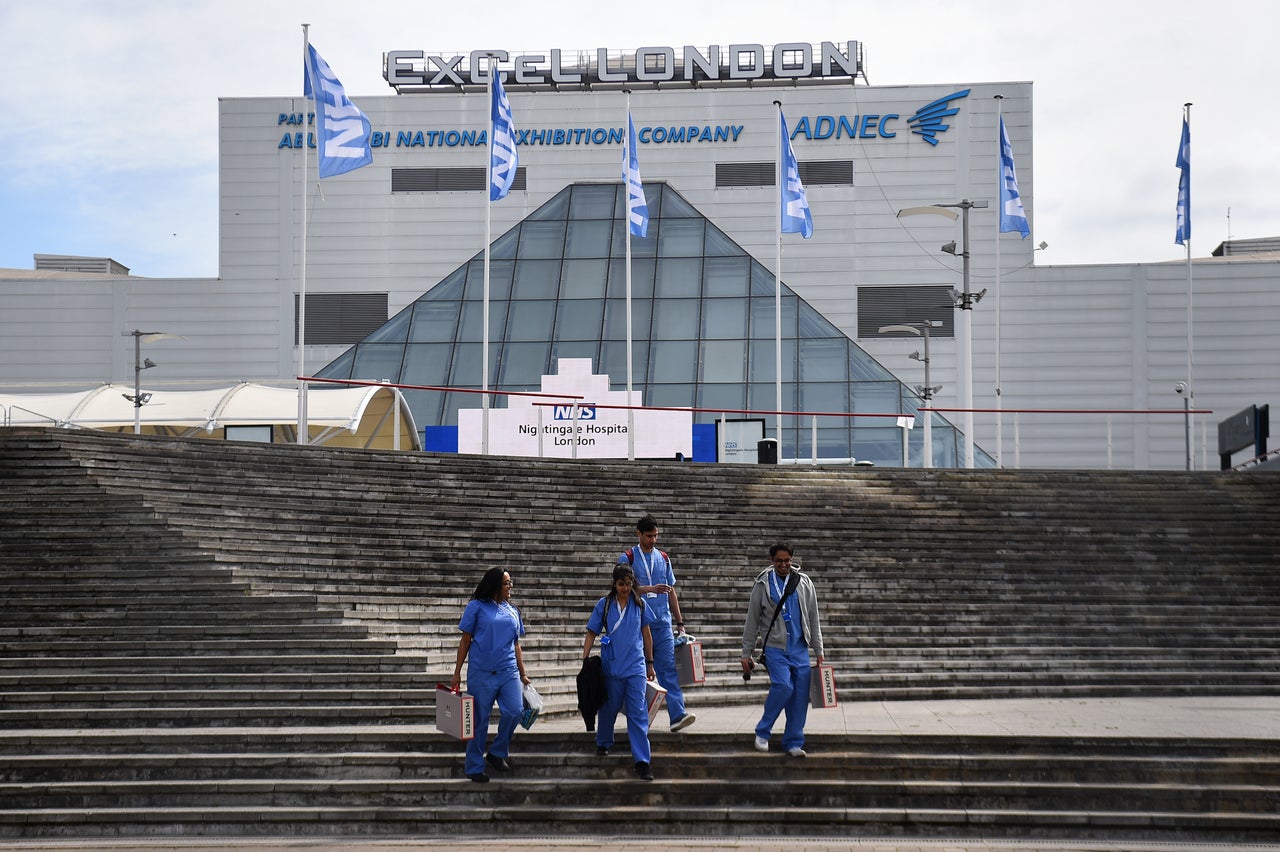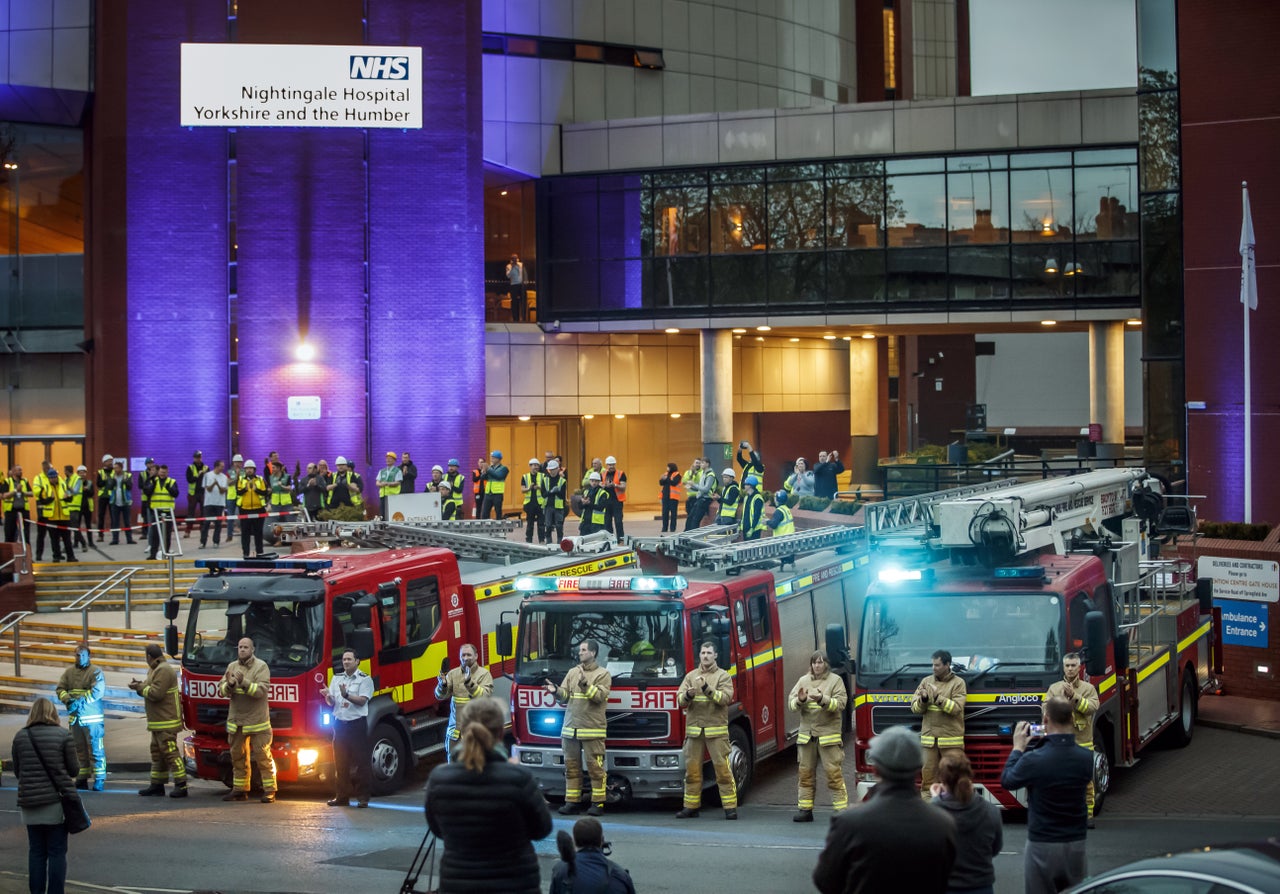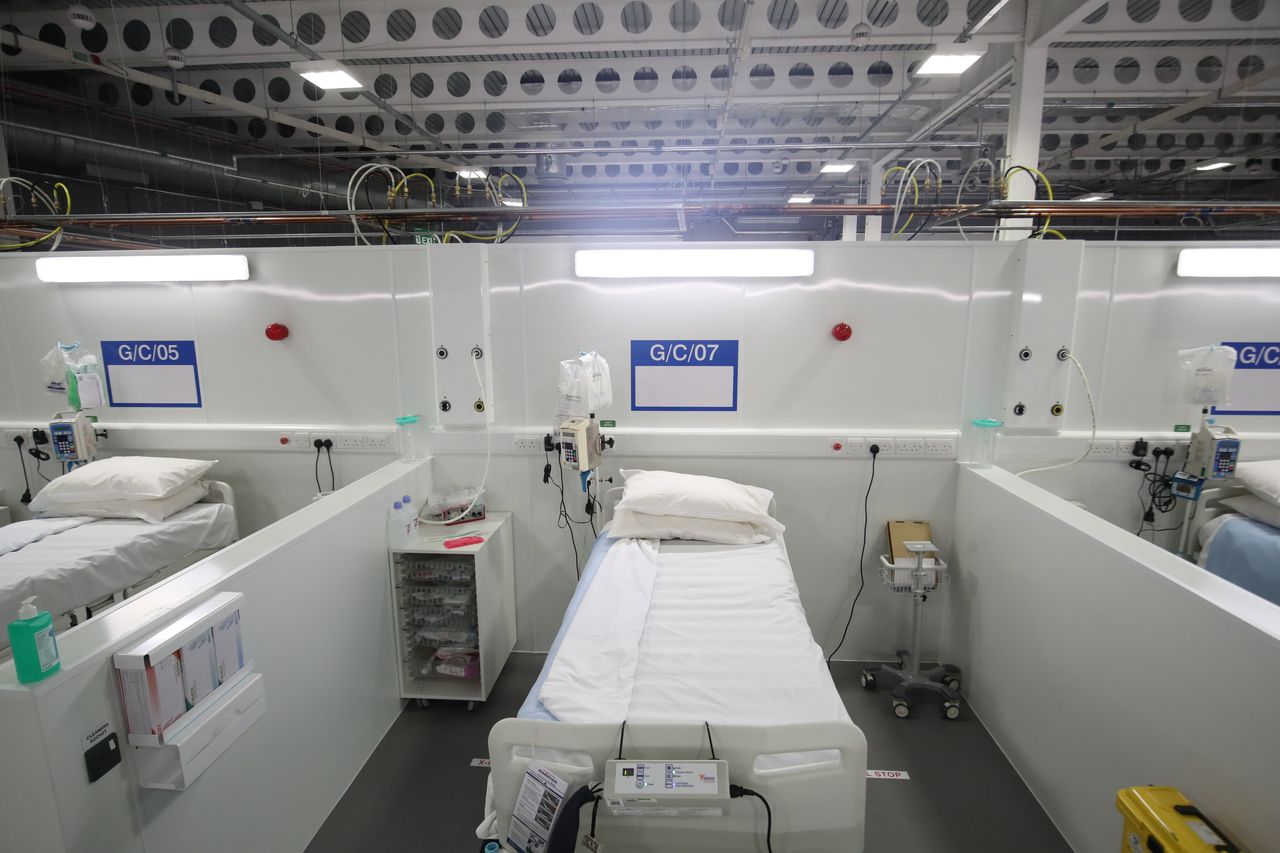Only three of England’s seven Nightingale hospitals have ever been used to treat Covid patients – despite costing the taxpayer more than £500m to set-up and keep on standby, HuffPost UK can reveal.
An investigation by this website has shown just how underused the landmark hospitals have been – with the government under fire for overseeing a programme described as a “massive white elephant” from the start.
We found four of the Nightingales, opened during the first wave of the pandemic, have never treated people with Covid-19 despite the government’s promises the hospitals would provide vital overflow capacity for the NHS.
And only two of the hospitals have been used to treat Covid patients in the current deadly second wave – despite Covid-19 alert levels being raised to five due to a material risk of the NHS being overwhelmed and patients being moved out of London from full hospital wards.

We can also reveal just how costly the Nightingales have been, with the set-up bill totalling up to £1.27m per inpatient as of January, according to figures we collated.
Justin Madders MP, shadow health minister, said: “It seems, from the information that has been gathered, that the Nightingales were criminally underused and were a massive white elephant conjured up by [health secretary] Matt Hancock to create a good headline without any real thought having gone into how they could best be used and whether they would be properly staffed.”
Medical unions also slammed the government’s failure to heed warnings there were never enough critical care staff to run the Nightingales from the outset.
Dr Claudia Paoloni, president of HCSA, said: “They were effectively deployed as a political symbol to show that something was being done at a time when the government was failing so dismally at the things we really needed, such as PPE to protect staff or quicker actions on lockdowns.”
NHS England has robustly defended the Nightingales, saying they were “the ultimate insurance policy” in case existing hospital capacity was overwhelmed.
But our investigation reveals the hospitals were barely used during the first wave of the pandemic, when hundreds of lives were being lost daily, and even during the current second wave were not significantly mobilised for Covid-19 care despite being ready and on standby.
The findings, obtained using Freedom of Information requests (FOI), show only 272 inpatients were treated at the Nightingales up until January of this year.

The Nightingale London, at the ExCeL centre, admitted 54 inpatients from April 8 to May 6, before effectively halting Covid-19 treatment.
Another 110 were admitted to the Nightingale North West in Manchester from April to June last year, while the Nightingale Exeter had treated 108 inpatients as of January 12.
The four other Nightingales – in Birmingham, Sunderland, Bristol and Yorkshire – have never been used for any Covid inpatient care despite thousands of beds being available for this purpose.
We can also reveal that one hospital – the Nightingale Birmingham, which was the most expensive to set-up at a contracted budget of £109million – has never been used at all.
Rosie Cooper MP, who sits on the Commons health and social care committee, said: “It’s understandable that there was a mad rush to get things done in the first wave. It is impossible to understand in the second wave why the hospitals weren’t used and why it’s cost so much money to so little effect.”
HuffPost UK’s investigation has also revealed the substantial price-tag for keeping the hospital buildings in limbo and mostly empty as the NHS battled under huge strain.
Data obtained using FOI requests shows each Nightingale building cost between £409,000 and £1.2m a month to keep on standby, based on the trusts that responded to our FOIs.
The Nightingale South West had a monthly standby budget of £1,208,000, the Nightingale Yorkshire £630,000 and the Nightingale Exeter £409,000.

The bill to set up the hospitals was £346m, according to contracts awarded by the government to NHS trusts, and NHS England has forecast total costs will run to £532m for the financial years 2019-21, including set-up, running and stand-by costs, and decommissioning the sites.
At least £850,000 was also spent with consultancy firms on the construction of the Nightingales, the FOI responses show – although this figure could be substantially higher as HuffPost UK faced blocks in trying to obtain the information.
The Department of Health and Social Care (DHSC) said FOIs should be directed to NHS England. NHS England said FOIs should be directed to hospital trusts, who in turn said FOIs should be directed to NHS England or did not provide the data.
Madders criticised the government’s lack of transparency over the Nightingales, saying three parliamentary questions he has submitted since November about patient numbers and staffing at the hospitals have not been answered.
“This highlights once again the government’s secretive approach to all things Covid and a real failure to address genuine questions about whether the money it has spent was used wisely during the pandemic,” the Labour shadow minister said.
The data from our FOI responses clearly shows that the Nightingales did not play any significant role in treating Covid-19 patients during the first wave of the pandemic.
As this was becoming increasingly clear to the public last summer, health secretary Matt Hancock announced on his Twitter account in June the hospitals would be converted into cancer testing centres to deal with a backlog of cases.
But even this did not come about, our findings show.
According to the trusts that responded to our FOI requests, only one Nightingale is known to have been used for any kind of cancer treatment – the Nightingale Yorkshire, which was used for diagnostic radiology CT scanning.
By the time the second national lockdown was announced on January 4, when the bitter current wave of the pandemic took hold, all of the Nightingales were on standby and ready for use.
Yet, once again, they were not called into action.
Only one of the Nightingales (Exeter) being significantly used to treat Covid-19 patients since January, we can reveal.
The Nightingale London has also treated two Covid patients, while the Nightingales North West and London have been used for non-Covid inpatient care, according to NHS data.
The non-mobilisation of the hospitals came despite significant strain on the NHS — with critically ill Covid patients being moved from London and the south-east to the West Country as hospital wards were overwhelmed.
Coronavirus patients were even reportedly transferred to converted hotels as London hospitals struggled with the influx of patients.

HuffPost UK asked all the trusts running the hospitals what types of patient treatment the Nightingales delivered if they were not being used for Covid-19 inpatient care.
The FOI responses show 6,335 outpatients were seen for CT scans and diagnostic tests between April last year and January this year at two Nightingales – Yorkshire (3,697 patients) and Exeter (2,638).
The Nightingale South West was also used for outpatient treatment, but did not provide numbers.
The Nightingales in London and Sunderland were used to support vaccine rollout and the Exeter Nightingale had treated 468 patients in Covid vaccine trials.
Even if the outpatient numbers provided as of January 4 are included in the calculation of costs per patient for setting up the Nightingales, the figure is still £52,000 per patient.
The Royal College of Nursing (RCN) said the government had been misguided in believing spending on beds and buildings would increase the NHS’s treatment capacity.
“Increasing capacity doesn’t just mean providing more equipment; it means providing the trained staff to operate it and provide high quality care,” said Jude Diggins, the RCN’s interim director of nursing, policy and public affairs.
“We entered this pandemic with almost 40,000 nursing vacancies in the NHS in England alone so it would have been difficult to fully staff these facilities safely.”
“The Nightingales were criminally underused and were a massive white elephant conjured up by [health secretary] Matt Hancock to create a good headline.”
- Justin Madders MP, shadow health minister
Dr Rob Harwood, consultants committee chair of the British Medical Association, echoed the criticism, saying: “It has been clear since the first wave that the Nightingales could not be utilised as well as they might have been given the chronic staffing shortages in the NHS.”
He called on the government to urgently address the workforce shortages.
HuffPost UK contacted NHS England and DHSC about the findings of this investigation.
An NHS spokesperson told us: “The Nightingale hospitals have been the ultimate insurance policy in case existing hospital capacity was overwhelmed as SAGE forecasted it could be last March and April, but thanks to a significant increase in existing critical care capacity, even when more than 100,000 patients with Covid were admitted in January, there were beds available across the country.
“When they have been needed, the Nightingales have been used to care for patients in ways that work best for their local community, whether that’s by offering step down care after a hospital stay, vaccinations or thousands of CT scans and tests, and part of their funding has been used to buy equipment and medical supplies which can be used elsewhere across the NHS.”
The hospital trusts running the Nightingales said they played an “invaluable role” in supporting non-Covid routine care.
DHSC did not respond to our request for comment.
The Nightingales will close permanently on April 1 this year.
How were the Nightingale hospitals used?
The Nightingale London treated 54 Covid in-patients in spring 2020 and has been used as a vaccination centre. It has admitted non-Covid inpatients from January to March this year and two Covid patients in February.
The Nightingale North West in Manchester treated 110 in-patients, including Covid patients, from April to June 2020 and has been used to treat non-Covid patients from January to March this year.
The Nightingale Birmingham has not been used at all throughout the pandemic.
The Nightingale South West in Bristol has been used to treat day patients from Bristol Royal Hospital for Children and to carry out eye assessments for Bristol Eye Hospital patients. No patient numbers provided.
The Nightingale Yorkshire in Harrogate has been used to treat 3,697 out-patients for radiology CT scans.
The Nightingale North East in Sunderland has been used to support the vaccine rollout.
The Nightingale Exeter had treated 108 Covid-positive patients as of January 12 this year, and continued to treat Covid patients until February 24. It also treated 2,638 outpatients for diagnostic tests and 468 volunteers in the Novavax Covid-19 vaccine study.
